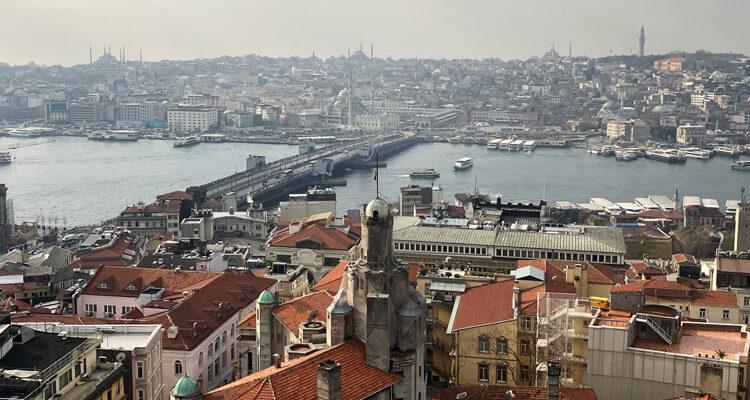Just try reconciling Istanbul’s eternal clashes. Unlike the modern expression of the word ‘literally’ — where Gen Zs will say, without irony, I literally died — Istanbul literally spans the East and West; Europe and Asia; the ancient and modern; the Islamic and Judeo-Christian traditions. It’s been a central trading hub and confluence of thousands of cultures for thousands of years. Spend a few minutes in an Istanbul café, observing and listening; you’ll realize there’s no such thing as different races, just one busy human race.
All that in mind, the following lists a smattering of Istanbul’s must-sees, glad-you-saw-thems, and oddities you might wish you’d never seen.
The Great
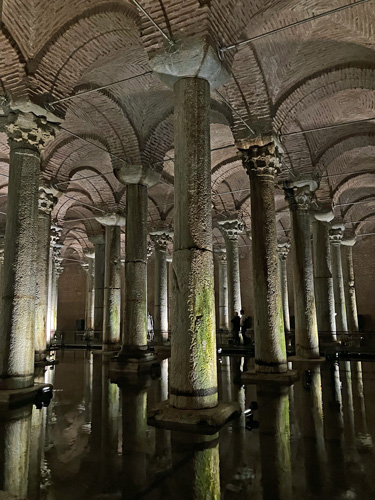
Built 1600ish years ago, the Basilica Cistern is the biggest of several underground manmade lakes, supplying water to Constantinople’s well-plumbed palaces and homes. Basilica has come to mean church in English, but the original Greek simply meant big rectangular building. This one big tank could hold 80,000 cubic metres of water, useful during a Dark Age siege with Berbers, Lombards or other barbarians at the gate. Supported by 366 30-foot columns arranged in 12 rows of 28, this reservoir seems unending at first. It’s ingeniously curated with evolving lights accentuating different aspects. Note the inconsistency of the column capitals and the immense marble Medusa heads, haphazardly used as column bases. This big tank was designed for function, underwater and underground, not display. Experts conclude much of it was constructed with materials from other decommissioned public projects. Locals mostly forgot the cisterns existed until fairly recent times. A friend said people would fish them from holes in their basements but otherwise didn’t afford them much thought. Fantastic.
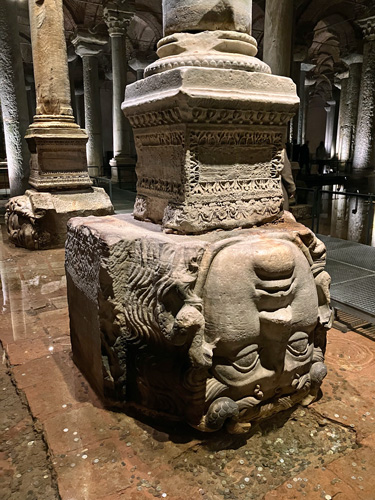
As ancient, the Aqueduct of Valens was commissioned by Emperor Constantine but completed by his successor Valens. Hence the name. Consider: working aqueducts would carry water for miles from uplands to populated places. The remains of Valens span nearly a kilometre between hills in Istanbul’s Fatih neighbourhood. How big is it? A six-lane highway passes between the lower level’s arches (eat your heart out, Don Valley) but is invisible depending on where you’re viewing Valens aqueduct from.
Still with those industrious Romans, the Hagia Sophia isn’t Istanbul’s biggest mosque, but is the oldest, most controversial and, well, it sure ain’t small. You’ll feel like an ant. Originally a Church — Constantine made Christianity the official religion of Rome — it faced Jerusalem instead of Mecca; angels and crosses peak out from acres of artistic Islamic branding. All interesting, yes, but its dome literally dominates your attention. Imagine the precision of the mathematics needed to conceive, never mind execute, its construction! Admission is free, so arrive early. NB: Facing the Hagia Sophia, across a park, is the temporarily closed Sultanahmet or Blue Mosque. But point your camera above the surrounding hoarding and it still makes a great selfie.
The Grand
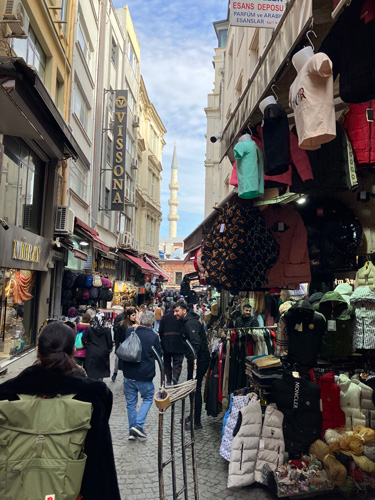
Stroll the Grand, Spice (Egyptian) and Arasta Bazaars — or, even better, the miles of outdoor stalls and stores bursting with tat and textiles, blocking traffic, sprawling across entire neighbourhoods. Whether you spend or not, the shopping here is a sensory overload. Enter and observe. Embrace the experience of getting lost. And prepare to be accosted by polylingual sales vultures aiming to sweettalk your reserved ‘how much is it in Canadian’ ass into a deal.
Warning: the proliferation of cuisines and lovely food might keep you from ticking all the boxes on your sightseeing list. Can’t blame you. Even the most touristy restaurants with men in fezzes serving at tables not two-feet high with cushions and carpets for sitting, while exotic string music bends quarter-tones in a subtle nine time, will thrill. Remember, you’re at the neck of the Black and Marmara Seas. Eat fish! And you’re basking in a climate that would embarrass the Garden of Eden. Complement your mains with plenty of salads. Serious foodies will love the dockside Kadiköy neighbourhood near the soon-to-open Istanbul Modern art gallery. Want a snack but on a tight schedule? Vendors of roasted chestnuts and street corn abound. Finally, yes, do grab a kebab.
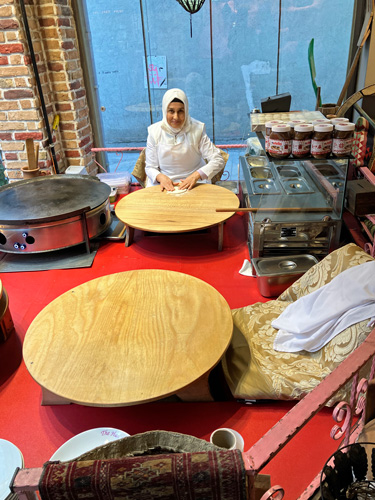
Maybe public transit sounds unimpressive but you try organizing this ocean of humanity built on an unending hedgerow of branching streets, squares and alleys. Huge trams with multiple cars snake through neighbourhoods. Their jealously dedicated routes eliminate traffic which jams early daily just feet away from your rapid ride. Modern metros roll quietly under 300km of sprawl punctuated with nearly 300 stations. Subterranean funiculars drag you up steep cobbled hills in seconds. And cheap ferries quickly float you around the Golden Horn and Bosphorus at a fraction of the cost of tourist boats next door offering the same. There are even a couple of gondola cars which act as both transit and sightseeing experiences at some of the city’s highest points. It’s all accessible by a single Istanbul City Card you can buy at most transit stops from machines that actually work. The interface offers multiple languages, distinguishable by their flags.
The Grotesque
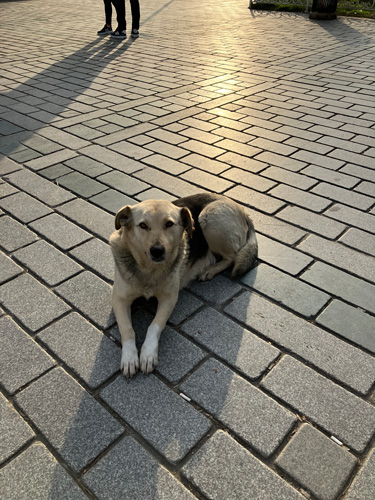
Stray dogs and cats roam the city but aren’t intimidating. Tourists and locals alike feed them. Notice the areas they congregate; piles of kibble are anonymously supplied. There’s an annex outside the Spice Bazaar advertising itself as the pet food bazaar (we didn’t ask if you can haggle over a package of plush mice filled with cat-nip). These animals are stray but not wild, mostly docile and domesticated if that’s possible outdoors. These dogs and cats even seem to coexist if not in perfect harmony, at least in uncomfortable dissonance. Speaking of …
Despite the continuing ‘special military operation’ in Ukraine, Russian tourists fill the streets and bars. To be fair, Russians have been visiting and doing business here for nearly a millennium. At important sights, you’ll see many signs in Turkish, Arabic, English and often Cyrillic. At 6am on the morning we left for the airport, we briefly shared our boutique hotel lobby with three men, each the size of an entire village, one of whom was unconscious on a sofa divan, the others, albeit quietly, talking over a nearly empty 60-ounce bottle of Hendricks Gin which they’d purchased off the shelf of the tiny bar. Imagine the impending hangover.
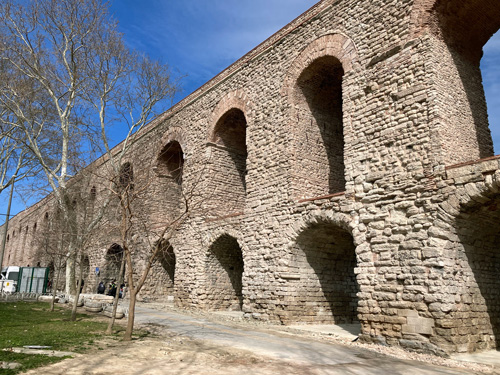
If you have a delicate constitution, don’t google Istanbul cosmetic surgery and hair replacement. Destination tourists come here for nose jobs and tree-farming. Which is fine; live and let live and all that. However, while in the post-op phase, too many use their recovery time to take in the sites. And it’s disturbing because you can’t help gawping. The women mosey about sporting small casts seemingly hacked from some medieval knight’s nose-guard and Gerry Cheever’s first goalie mask. Contrasting the monochromatic peach of her cast, bruises and iodine stains spread across the woman’s remaining exposed face. (We did see one young man wearing the post-op cast but, clearly embarrassed, he hid much behind oversized sunglasses and an N95 mask.)
Each public encounter, rhinoplasty or tresstoration, is unexpected and alarming. So you might suddenly choke on your shisha or expel the mouthful of tandoor kebab that was, minutes before, lovingly prepared before you over an open flame.
Ah, travel!



